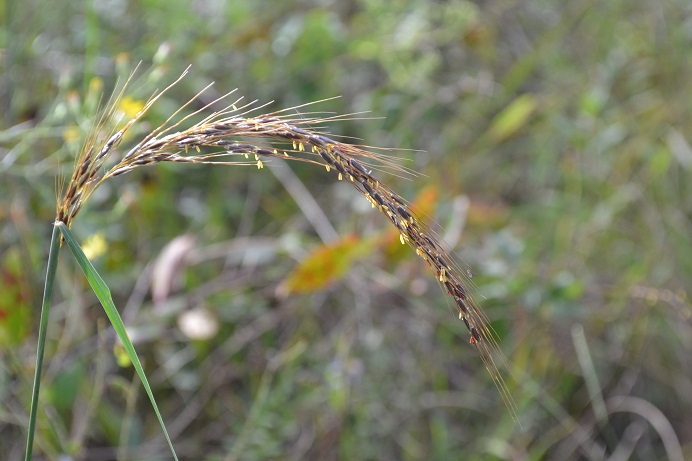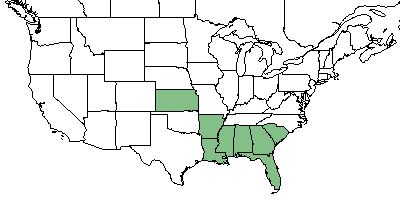Sorghastrum secundum
| Sorghastrum secundum | |
|---|---|

| |
| Photo by Kevin Robertson | |
| Scientific classification | |
| Kingdom: | Plantae |
| Division: | Magnoliophyta - Flowering plants |
| Class: | Liliopsida - Moncots |
| Order: | Poales |
| Family: | Poaceae |
| Genus: | Sorghastrum |
| Species: | S. secundum |
| Binomial name | |
| Sorghastrum secundum (Elliott) Nash | |

| |
| Natural range of Sorghastrum secundum from USDA NRCS Plants Database. | |
Common Name(s): lopsided indiangrass[1][2]
Contents
Taxonomic Notes
Synonym(s): Andropogon secundus[2]
Description
Sorghastrum secundum is a monoecious perennial graminoid[2] that grows to 3-6 feet (0.91-1.83 m).[3] It is a tufted grass with short rhizomes.[4] Culms are erect to ascending and blades are up to 8.1 mm (0.32 in) wide and 42 cm (1.38 ft) long. Straight inflorescence with spikelets positioned all on one side helps distinguish this species.[5]
Distribution
S. secundum occurs from southern South Carolina, south to southern Florida, and westward to southern Alabama.[1]
Ecology
Habitat
This species is found on sandhill and other upland pine communities[1] and thinly wooded areas.[5] In peninsula Florida xeric sandhills, S. secundum was found in 100% of the plots with a mean cover of 0.0299 m2. Panhandle xeric sandhills contained S. secundum in 87% of plots and had a mean coverage of 0.0191 m2. Frequency and mean cover in northern Florida longleaf ("clayhill") woodlands was 100% and 0.04 m2 and 94% and 0.0273 m2 in northern Florida subxeric sandhills, respectively.[6] S. secundum responds negatively to agricultural-based soil disturbance in historically longleaf communities of South Carolina.[7] It also responds negatively to agricultural-based soil disturbance in South Carolina coastal plain communities. This marks it as a possible indicator species for remnant woodland.[8] S. secundum responds negatively to soil disturbance by agriculture in Southwest Georgia.[9] It also responds negatively to soil disturbance by clearcutting and chopping in North Florida flatwoods forests.[10]
Phenology
Flowering occurs in September and October in Central Florida and northward.[1][5] In southern Florida, blooming begins in July.[5]. Seed germination seems to peak in January and February.[11]
Seed dispersal
This species is thought to be dispersed by gravity. [12]
Seed bank and germination
In south Georgia, S. secundum buried in seed bags had a 26% germination rate after one year, 34% after two, and 9% after four.[11] Following a 1999 cohort in South Carolina, 40% of recruits were alive after three years.[13]
Fire ecology
Fire, especially when followed by freezing or high rainfall, kills or reduces growth in S. secundum. A model suggests longer fire return, such as a three year interval or combination of two, three, and four year intervals will best result in a stable population.[14]
Use by animals
S. secundum consists of 2-5% of the diet for terrestrial birds.[15] Fire ants (Solenopsis invicta), do not show an interest in S. secundum seeds.[16] In the southeastern United States, it is also grazed year round.[14] Models suggest herbivory of S. secundum decreases as patched become more isolated from each other[17] and field measurements in South Carolina suggest a given leaf had a 9% probability of herbivory.[18]
Diseases and parasites
Its seeds are more prone to mold destroying it prior to germination compared to other seeds.[11]
Conservation and Management
Cultivation and restoration
Photo Gallery
References and notes
- ↑ 1.0 1.1 1.2 1.3 Weakley AS (2015) Flora of the Southern and Mid-Atlantic States. Chapel Hill, NC: University of North Carolina Herbarium.
- ↑ 2.0 2.1 2.2 USDA NRCS (2016) The PLANTS Database (http://plants.usda.gov, 16 January 2018). National Plant Data Team, Greensboro, NC 27401-4901 USA.
- ↑ Plant database: Sorghastrum secundum. (16 January 2018) Lady Bird Johnson Wildflower Center. URL: https://www.wildflower.org/plants/result.php?id_plant=SOSE5
- ↑ Dagley CM, Harrington TB, Edwards MB (2002) Understory restoration in longleaf pine plantations: Overstory effects of competition and needlefall. In: Outcalt KW ed. Proceedings of the eleventh biennial southern silvicultural research conference. General Technical Report SRS-48. Asheville, NC: U.S. Department of Agriculture, Forest Service, Southern Research Station.
- ↑ 5.0 5.1 5.2 5.3 Hall DW (1982) Sorghastrum (Poaceae) in Florida. SIDA 9(4):302-308.
- ↑ Carr SC, Robertson KM, Peet RK (2010) A vegetation classification of fire-dependent pinelands of Florida. Castanea 75(2):153-189.
- ↑ Brudvig, L.A. and E.I. Damchen. (2011). Land-use history, historical connectivity, and land management interact to determine longleaf pine woodland understory richness and composition. Ecography 34: 257-266.
- ↑ Brudvig, L.A., E Grman, C.W. Habeck, and J.A. Ledvina. (2013). Strong legacy of agricultural land use on soils and understory plant communities in longleaf pine woodlands. Forest Ecology and Management 310: 944-955.
- ↑ Kirkman, L.K., K.L. Coffey, R.J. Mitchell, and E.B. Moser. Ground Cover Recovery Patterns and Life-History Traits: Implications for Restoration Obstacles and Opportunities in a Species-Rich Savanna. (2004). Journal of Ecology 92(3):409-421.
- ↑ Moore, W.H., B.F. Swindel, and W.S. Terry. (1982). Vegetative Response to Clearcutting and Chopping in a North Florida Flatwoods Forest. Journal of Range Management 35(2):214-218.
- ↑ 11.0 11.1 11.2 Coffey KL, Kirkman LK (2006) Seed germination strategies of species with restoration potential in a fire maintained pine savanna. Natural Areas Journal 26(3):289-299.
- ↑ Kirkman, L. Katherine. Unpublished database of seed dispersal mode of plants found in Coastal Plain longleaf pine-grasslands of the Jones Ecological Research Center, Georgia.
- ↑ Harrington TB, Dagley CM, Edwards MB (2003) Above- and belowground competition from longleaf pine plantations limits performance of reintroduced herbaceous species. Forest Science 49(5):681-695.
- ↑ 14.0 14.1 Penfield S (2006) Notes on some characteristics of lopsided indiangrass (Sorghastrum secundum). Noss RF (ed) Land of Fire and Water: The Florida Dry Prairie Ecosystem. Proceedings of the Florida Dry Prairie Conference. pp 176-181
- ↑ Miller JH, Miller KV (1999) Forest plants of the southeast and their wildlife uses. Southern Weed Science Society.
- ↑ Cumberland MS, Kirkman LK (2013) The effects of the red imported fire ant on seed fate in the longleaf pine ecosystem. Plant Ecology 214:717-724.
- ↑ Brudvig LA, Damschen EI, Haddad NM, Levey DJ, Tewksbury (2015) The influence of habitat fragmentation on multiple plant-animal interactions and plant reproduction. Ecology 96(10):2669-2678.
- ↑ Levey DJ, Caughlin TT, Brudvig LA, Haddad NM, Damschien EI, Tewksbury JJ, Evans DM (2016) Disentangling fragmentation on herbivory in understory plants of longleaf pine savanna. Ecology 97(9):2248-2258.